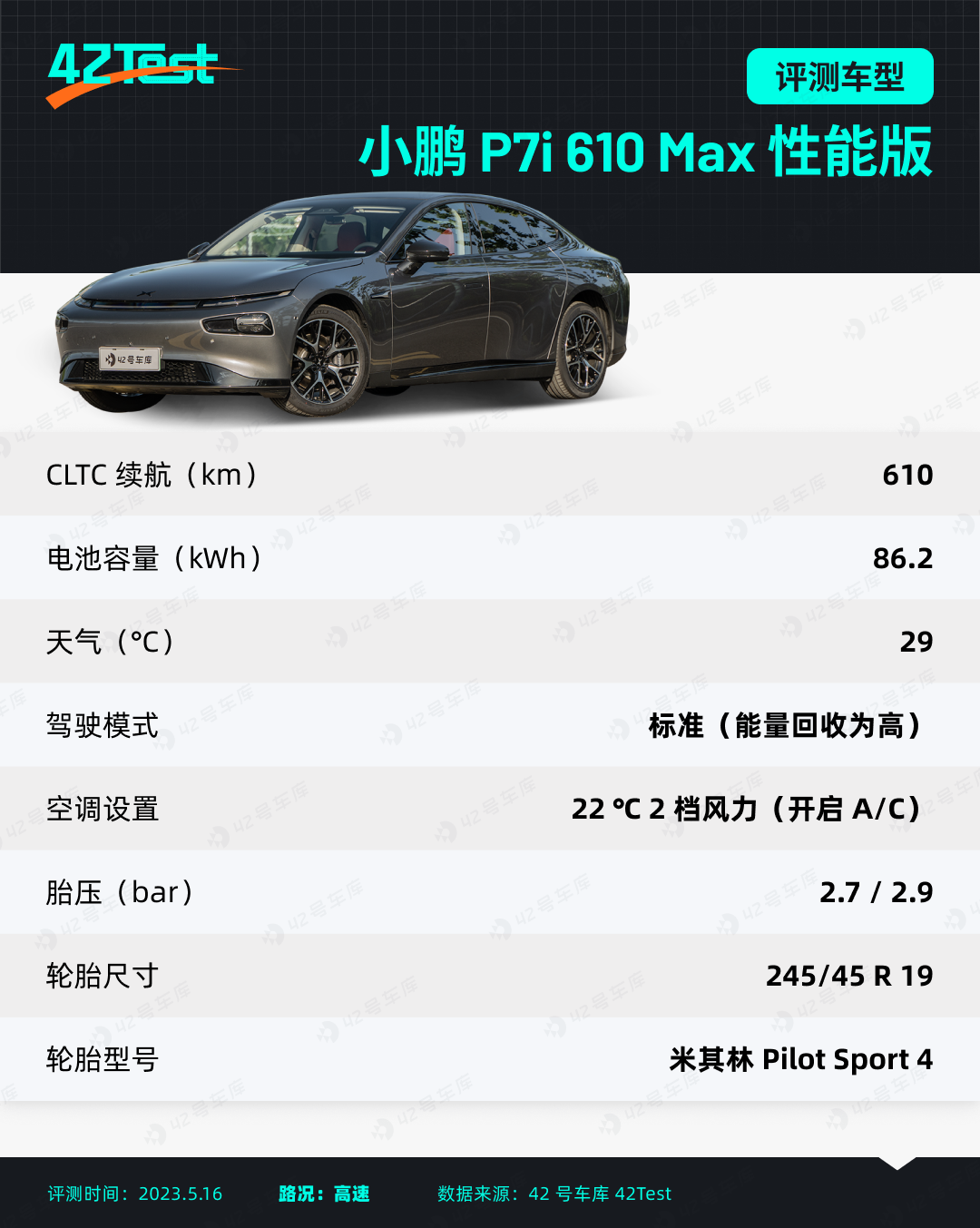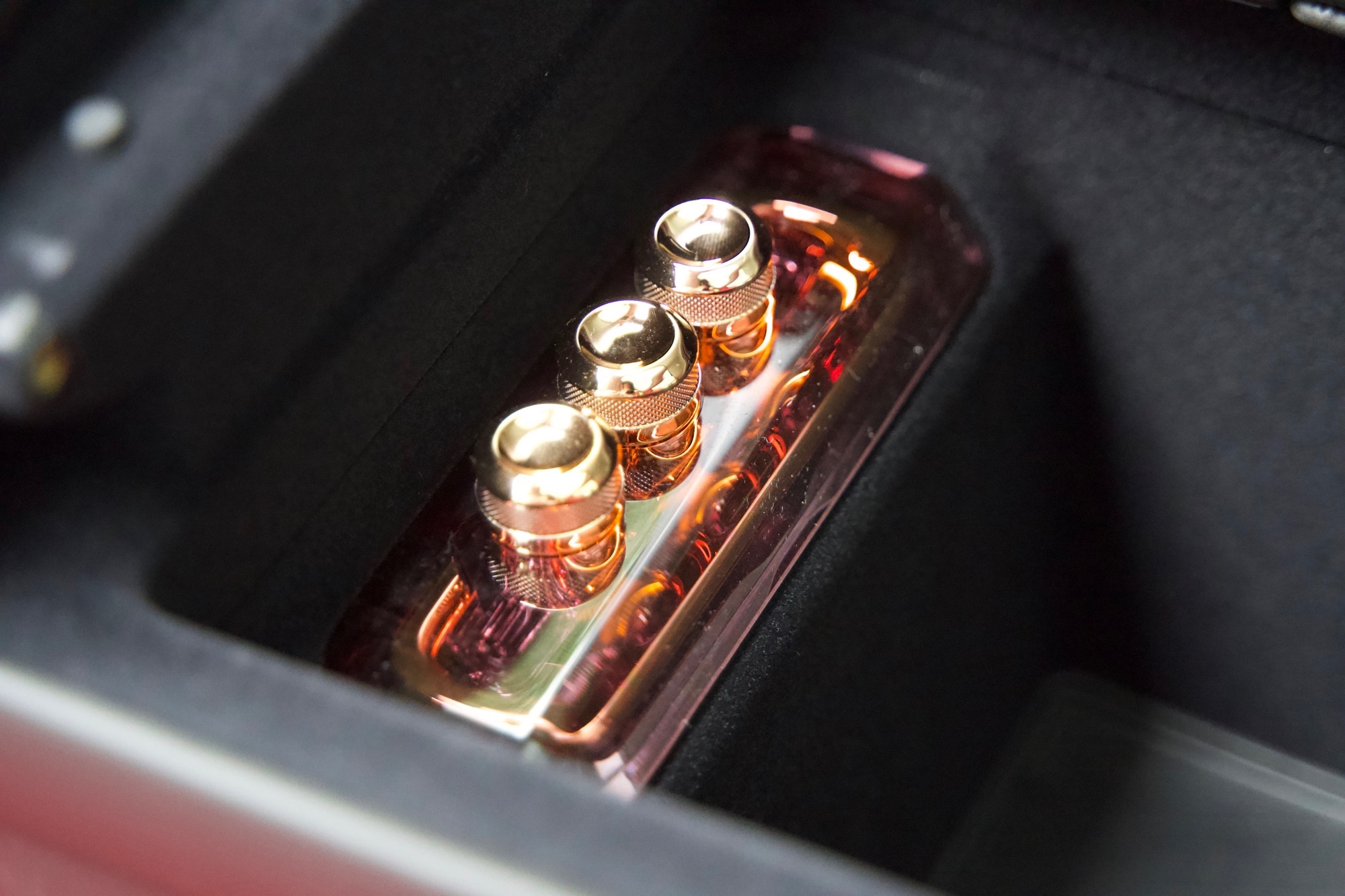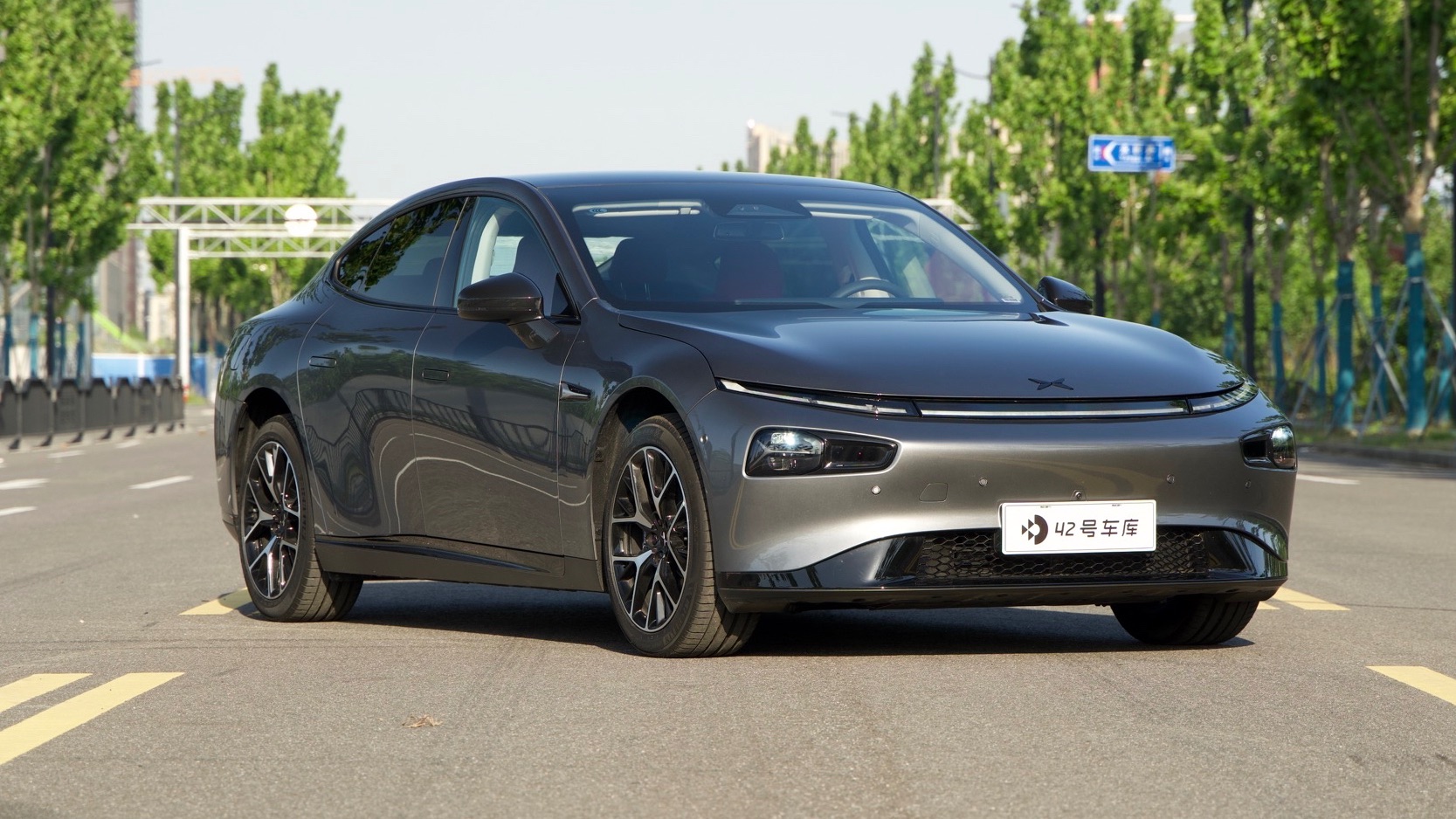When it comes to XPeng’s star product, the P7 undoubtedly comes to mind. This is because this model has elevated the brand and sales of XPeng Motors to a higher level.
Fast forward to 2023, the XPeng P7 received a major update as a product that focuses on intelligence, with the new 8155 in-car chip and the addition of two LiDAR sensors. Assisted driving capabilities have increased more than eightfold, and the name has been changed to P7i. Previously, we had test-driven the new P7i on different tracks, but we have not yet conducted systematic tests on its actual endurance and basic performance.

For this edition of 42Test, we invited the XPeng P7i 610 Max Performance version for a detailed test. This model is positioned as a sub-top, dual-motor, four-wheel-drive configuration with an 86.2 kWh ternary lithium power battery, and a CLTC combined working condition range of 610 km.
The test model is not a mass-market version of the P7i, as the lower-priced single-motor versions with the same capacity power battery can achieve a CLTC combined working condition range of up to 702 km, just with less powerful performance.
Driving Experience: Strong Absolute Performance and Comfortable Daily Driving
The XPeng P7i we tested has a rear-mounted permanent magnet synchronous motor with a maximum power of 203 kW and a maximum torque of 440 N·m, and a front-mounted induction motor with a maximum power of 145 kW and a maximum torque of 317 N·m. The system has a combined maximum power of 348 kW and a maximum torque of 757 N·m.


For the dynamic performance of the XPeng P7i, we previously had an in-depth experience at the Mayong Circuit in Dongguan, Guangdong. Those interested can also watch the video XPeng P7i Track Drag Race.
Acceleration & Braking Performance
XPeng officially announced the P7i’s 0-100 km/h acceleration time as 3.9 seconds. Under temperature conditions of 26 °C, our fastest tested acceleration time for the same range was 4.0 seconds, which is essentially in line with the official figures. It is worth noting that after conducting 10 consecutive acceleration tests, the P7i’s 0-100 km/h performance remained stable at 4.1 seconds with no decline, demonstrating an excellent performance.
 We then conducted a braking test at a temperature of 28°C, with the shortest braking distance for the XPeng P7i from 100 km/h to 0 being 35.7 meters. As seen in the data table, there is a declining trend in the braking performance during the seven consecutive tests. However, after cooling the braking system and retesting, it returns to normal levels.
We then conducted a braking test at a temperature of 28°C, with the shortest braking distance for the XPeng P7i from 100 km/h to 0 being 35.7 meters. As seen in the data table, there is a declining trend in the braking performance during the seven consecutive tests. However, after cooling the braking system and retesting, it returns to normal levels.
Overall, the braking performance of the XPeng P7i is somewhat inconsistent, with a difference of 4.9 meters between the shortest and longest braking distances in the first seven consecutive tests.
In fact, the tire and braking system hardware of the XPeng P7i are both of good quality.
The tires are Michelin Pilot Sport 4, with equal dimensions of 245/45 R 19 102W for all four wheels. The speed rating of this tire is 270 km/h, and the load capacity for each tire is 850 kg, meeting the owner’s requirements.


The braking system is also relatively advanced, with four-piston Brembo calipers for the front wheels, and Brembo ventilated brake discs for all four wheels.

Daily Driving Experience
The XPeng P7i performs excellently in terms of absolute power. The more powerful Sport mode is better suited for mountain driving or racetracks. For everyday driving, Standard or Comfort mode might be the better options.

The overall daily driving experience leans more towards sportiness, with responsive throttle and braking. The steering feel is light at low speeds and stable at high speeds. However, when switching the steering mode to Sport, the electronic feel becomes more apparent.
The suspension and shock absorption are also sporty. It’s comfortable when driving over bumps at high speeds, with more vehicle body movement over bumps at low speeds, but the overall tuning is satisfactory.


In conclusion, the XPeng P7i meets the needs of daily urban commutes, with a remarkable daily driving experience.
NVH Performance
Considering its hardware, the XPeng P7i uses only single-pane glass. Will its noise performance be poor?
 The answer is not as such.
The answer is not as such.
During the noise test, we closed all windows, air conditioning, audio, seat massage, driving assistance, and other features with sound, while clearing all items from the car to ensure that they do not affect the test results. Then, we drove at speeds of 0, 60, 80, 100, and 120 km/h in a closed road, collecting three samples of the noise level at the driver’s ear and taking the average value.

As seen, the noise performance of the XPeng P7i didn’t worsen due to the use of single-layer glass, particularly at 120 km/h, where the noise performance is quite outstanding.
Range Test: Excellent Energy Consumption Performance
In today’s challenging recharging and charging landscape, the range is a fundamental quality of a purely electric vehicle. Before the test, I was mentally prepared that the four-wheel drive version of the XPeng P7i might have a shorter range as dual motors consume more energy.
Highway Range: Accurate Displayed Range
However, the actual situation was significantly better than expected. We conducted the high-speed range test in temperatures of 29 °C, with the air conditioning set at 22 ℃, 2 wind force levels, and A/C enabled. Meanwhile, front and rear tire pressures were standard at 2.7 Bar and 2.9 Bar, respectively. The driving mode was set to “Standard,” with energy recovery adjusted to “High.”

Under these testing conditions, we completed 464.1 km of high-speed range, and at the end of the test, there was still 26.1 km of remaining range under the WLTC standard.

The result was satisfying. If the instrument range display were based on the WLTC cycle, the displayed range-to-actual distance ratio would be 1:1.03, indicating that the displayed range and actual range were very close. According to this ratio, the theoretical full-charge range of the XPeng P7i 610 Max Performance Edition should be 489 km.

The highway section on the test day was relatively unobstructed, taking a total of 5 hours and 22 minutes, with an average speed of 87 km/h, quite in line with daily usage scenarios.
City Range: Higher Energy Consumption
After fully charging, we conducted a 150 km city range test. According to 42Test’s test standards, the city range test includes 2 parts: a 50 km ground section passing through traffic arteries such as Dingxi Road, Century Avenue, Xuhui Riverside, and Wukang Mansion; and a 100 km loop around the Outer Ring Highway, which is consistently plagued by heavy traffic and complex road conditions.
Throughout the test, our average speed was 36 km/h, and it took 250 minutes to complete the 150 km stretch. After the test, we found that the displayed range of XPeng P7i had decreased by 141 km, which means that the displayed range was slightly underestimated during this test.

The energy consumption performance differs in high-speed and urban scenarios. At high speed, the energy consumption can reach 17.1 kWh/100 km, while in urban settings, it is slightly higher at 17.2 kWh/100 km. The P7i is more energy-efficient on highways and consumes more energy on urban roads.

In summary, if you use the dual-motor all-wheel-drive version of the XPeng P7i as your daily driver, its performance is more than sufficient but also has relatively higher energy consumption. On the other hand, it is more energy-efficient during high-speed cruising, and the power delivery is much more responsive for acceleration and overtaking.
Charging Test:
As the P7i is still equipped with a 400V battery, we conducted the charging test using a 120 kW Xiaojuzi charging station based on the 42Test standard.
It took 64 minutes for the XPeng P7i to charge from 5% to 95% battery level, which is just over an hour for a full charge. The maximum charging power can reach 98.3 kW and starts to decline after reaching 75% battery level. The charging power remains above 20 kW until the charging process is almost finished, demonstrating a pretty good performance.

This is still some distance from the XPeng G9, which supports 800V charging, but the gap is not significant. Tested with the same 120 kW Xiaojuzi charging station at approximately the same ambient temperature, the G9 has a maximum charging power of more than 120 kW. However, its charging time from 5% to 95% still takes 53 minutes. Using XPeng’s self-built charging stations would result in a more noticeable improvement in charging speed.
Exterior Design and Interior: Minor Changes, Improved Experience
Regarding the exterior and interior of XPeng P7i, we have already done a detailed unboxing and explanation in “XPeng P7i Fast Unboxing”. We believe that you will have a better understanding of this car after watching the video and reading the text simultaneously.Striking Appearance with High Aesthetic Value
In terms of exterior design, the P7i bears almost no difference from the previous P7 model. Nevertheless, I believe the 2020 design remains attractive to this day. Let’s first look at the dimensions, including length, width, height, and wheelbase, which are virtually identical to the XPeng P7, except for the P7i being 8mm longer.

The front-end features continuous headlights and seamlessly integrated laser radar, resulting in a sleek design without any abrupt elements. It is worth noting that some entry-level XPeng P7i models do not come with laser radar, but their exterior designs are indistinguishable from the higher-end versions.



The vehicle’s body lines are equally captivating, with a sporty coupe-like stance that is lower at the front and higher at the rear. Paired with pop-out door handles, the car exhibits enhanced integration while in motion.

At the rear, the segmented-through taillights follow current design trends. The all-wheel-drive version also features an exclusive black badge, which complements the Tianshen Gray body color while adding a sporty touch to the overall appearance.


The DC and AC charging ports of the XPeng P7i are located on the left and right sides of the car, respectively, both at the rear, making them practical for charging. However, a noticeable drawback is the lack of an intuitive charging port opening method, which is only accessible through voice command, the infotainment screen, or a mobile app. Unfortunately, the P7i does not have a straightforward push-to-open cover.


A similar lack of intuitiveness was present in the previous XPeng P7 model, featuring even more obscure opening methods. The P7i has addressed this issue by adding a switch button on the trunk lid, making it more convenient for everyday use.
Interior: Minor changes, hardware upgrades
Moving on to the interior, the design of the XPeng P7i’s cabin is youthful, and compared to the previous model, there are virtually no changes.

The most notable change is the steering wheel, which has been replaced with the G9 model’s steering wheel. I have used the older XPeng P7 for a while, and I often accidentally pressed the large buttons on the steering wheel when turning. I don’t know if anyone else has experienced this. After switching to the new steering wheel, I no longer encountered accidental presses during daily use.



The two-tone design and dual-hub steering wheel styling are also quite excellent. The upper part of the steering wheel features infrared illumination for the DMS camera. However, this is invisible to the human eye and not a shifting indicator light like on a Ferrari.
The XPeng P7i sports a column-type gear selector, similar to Tesla. To enable assisted driving, move it down twice, and to cancel assisted driving, move it up or press the brake pedal.

The left lever integrates turn signals, high and low beam headlights, and wiper functionality.

The two screens inside the vehicle are the same as in the older model, with a 10.25-inch instrument display and a 14.96-inch center control screen. The real upgrade lies in the chip: the older model features a Qualcomm 820A automotive chip, while the new model has undergone an intergenerational upgrade, equipped with a Qualcomm Snapdragon 8155 chip.


 In terms of processing performance, the 8155 has a noticeable improvement compared to the 820A, as the latter was released in 2016 and is relatively outdated.
In terms of processing performance, the 8155 has a noticeable improvement compared to the 820A, as the latter was released in 2016 and is relatively outdated.
In terms of smoothness, the new in-car infotainment system feels similar to the old one, being sufficiently smooth and user-friendly, with almost all in-car features integrated into the screen. From an ergonomics perspective, I have one complaint, which is that it’s inconvenient to touch the bottom edge of the screen as fingers are obstructed by the center console – an issue also present in the old P7 model.
Below the center console, there is a convenient place to put a phone, but only the left side supports wireless charging, while the right side does not, which is the same as the G9 model.

Therefore, if the passenger needs to charge their phone, they must connect a charging cable. However, both charging ports are located closer to the driver, seemingly giving the driver’s charging needs higher priority.

The storage space beneath the center armrest is not particularly large, especially with the fragrance system taking up some space. One good feature is that the storage area’s lid can be opened to the left or right, making it convenient for the driver and passenger to access items.


The seats in the XPeng P7i feature Nappa leather upholstery, which is smooth and comfortable to the touch. However, due to the car’s sportier positioning, the seats are not soft, with a greater focus on the sport seat’s wraparound effect. During our test in early summer, turning on the seat ventilation feature prevented it from feeling stuffy. In winter, the heated seat function will keep you even warmer.


Moving on to the rear seats, the material is almost identical to the front, but as a person with a slightly overweight body type, I didn’t find the rear seats as comfortable. You can refer to the following images for a look at the rear space.




The rear row also features one USB-A and one USB-C port, catering to different users’ needs.

Next, let’s talk about the audio system, which has also been upgraded on the XPeng P7i. The P7i 610 Max model comes standard with an Xopera audio system, and for an additional 6,000 RMB, you can opt for the Dynaudio Confidence series speakers. Both audio systems support 7.3.4 Dolby Atmos and have 20 speakers with independent amplifiers.




In terms of audio quality, it matches the P7i’s positioning. Playing Dolby Atmos sources provides a better sense of directionality. Also, it is not recommended to connect your phone via Bluetooth for music playback, as the sound quality might be somewhat lower compared to the in-car system.
Moving on to the trunk, the overall space is quite well-organized. Folding the rear seats down creates even more storage space.



However, the XPeng P7i doesn’t have a front trunk; opening the front hood reveals a neatly arranged plastic panel without any storage function.

Driver Assistance
During my ten-plus days driving the XPeng P7i, I always activated the driver assistance features whenever possible.
The sensor configuration is as follows:
- 2 LiDAR sensors
- 12 cameras (including DMS camera)
- 5 millimeter-wave radars
- 12 ultrasonic radars




The two auxiliary driving chips are Nvidia Orin chips, with a total computing power of 508 TOPS. This set of auxiliary driving hardware is also on par with the G9.
After activating the NGP navigation-assisted driving feature on highways, the XPeng P7i can travel along the navigation route. With high-precision positioning and high-definition maps, NGP’s lane-centering function is nearly flawless, and its ACC acceleration and deceleration are a bit cautious, making it prone to being cut off in congested traffic.
Regarding entering and exiting ramps, XPeng’s NGP performs relatively well. Still, it is recommended to manually enter and exit ramps in densely populated traffic areas.
Furthermore, XPeng’s city NGP feature is being progressively activated. If you’re interested, we can schedule it for a 42Mark column.
Final Thoughts
In 2020, the XPeng P7 was launched and genuinely became a best-selling vehicle for the XPeng brand. Nearly three years later, testing the XPeng P7i again, although it doesn’t have the same excitement as before, this car brings an excellent intelligent experience, which is the true essence of XPeng.

This article is a translation by ChatGPT of a Chinese report from 42HOW. If you have any questions about it, please email bd@42how.com.
